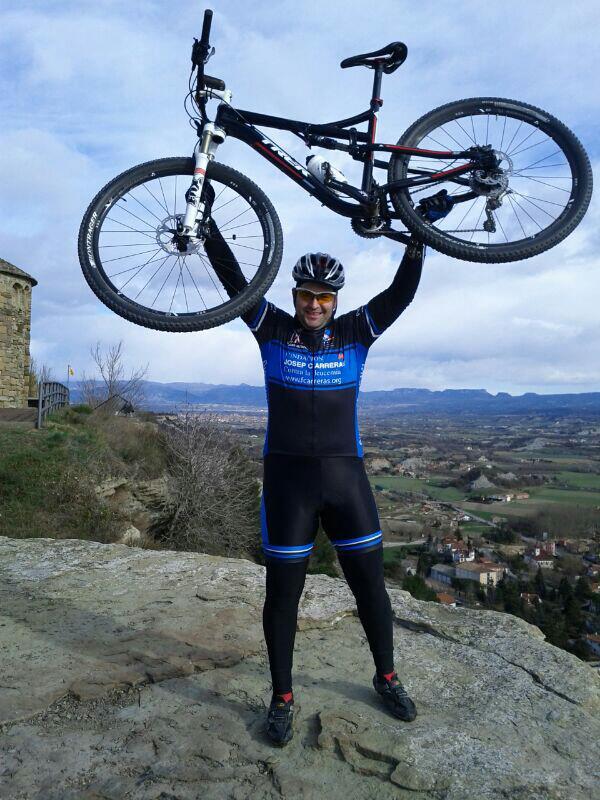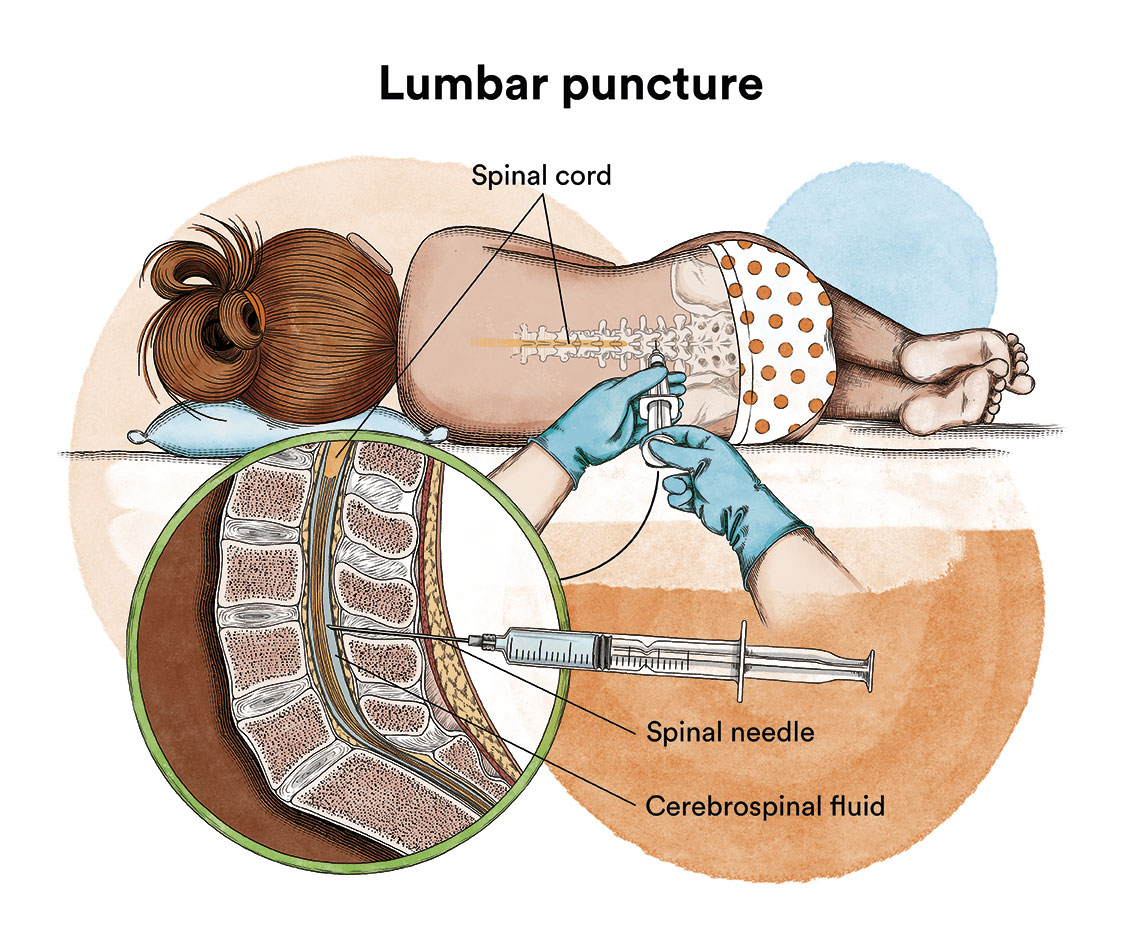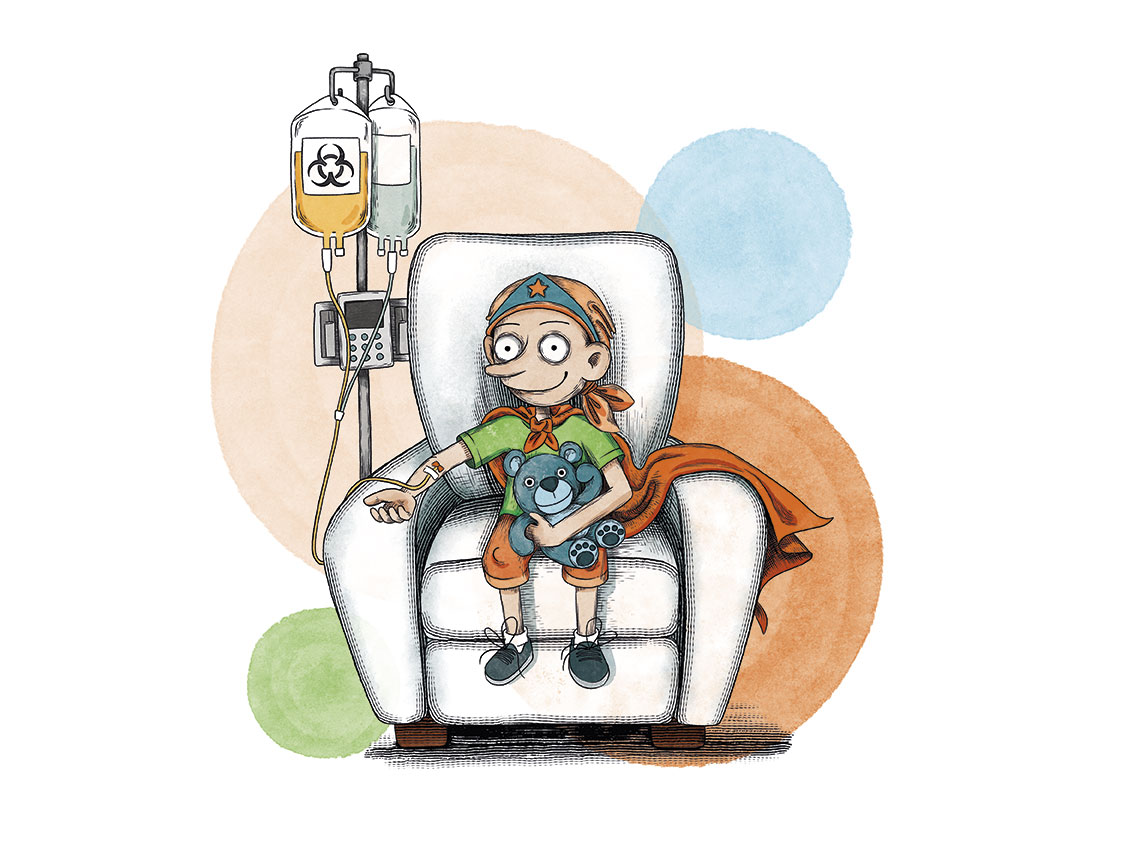Burkitt’s lymphoma
The information provided on www.fcarreras.org is intended to support, not replace, the relationship that exists between patients/visitors to this website and their physician.

José Antonio
Burkitt Lymphoma.
“In 2012, life smiled on me, I had a promising future, a good job, friends with whom to have fun and joke and, of course, bosses to argue with. But, like many, I thought everything was uphill. Everything was complaining. But one day they gave me the news, the worst news, the one you never expect: I was diagnosed with Burkitt’s lymphoma. Thanks to the support of my family, my girlfriend, my friends, and the great professionals who help us, I gained incredible strength and said that I had to win this battle. I did so and today I am healthy and have had a son. Strength and encouragement to all!”
Information reviewed by Dr. Rocío Parody Porras, Doctor specialising in Haematology. Member of the Management of REDMO (Bone Marrow Donor Registry) and of the Foundation’s medical team. Barcelona Medical Association (Co. 35205)
What is Burkitt’s lymphoma and who does it affect?
Burkitt’s lymphoma, also known as small non-cleaved cell lymphoma, is a type of aggressive non-Hodgkin’s lymphoma that mainly affects children and adolescents or young adults. In adults, it is a rare entity, accounting for less than 1% of lymphomas. It occurs most often in males, usually between the ages of 5 and 10 years. There are three main types of Burkitt’s lymphoma: sporadic, endemic and immunodeficiency-related. Sporadic Burkitt’s lymphoma occurs worldwide, endemic Burkitt’s lymphoma occurs in central Africa and immunodeficiency-related Burkitt’s lymphoma is most commonly seen in patients infected with the HIV virus. Some forms of Burkitt’s lymphoma are related to the Epstein-Barr virus. It is named after the physician Denis Parsons Burkitt who, working in equatorial Africa, described the disease in 1956.
- The sporadic variant of Burkitt’s lymphoma (also known as the non-African variant) is associated with Epstein-Barr virus infection.
- The endemic (of African) variant of Burkitt’s lymphoma occurs in equatorial or central Africa. It is the most common cancer among children in that region of the world. These children usually also have chronic malaria infection and it is thought that this may be the reason for the reduced resistance to Epstein-Barr virus. African children usually develop this lymphoma in the jaw or other facial bones.
- The immunodeficiency-associated variant of Burkitt’s lymphoma is particularly related to the HIV virus or immunodeficiency due to a previous transplant or in cases where a patient is receiving immunosuppressive drugs.
Burkitt’s lymphoma starts in the B lymphocytes. As discussed above, some types of Burkitt’s lymphoma are associated with an Epstein-Barr virus infection or a weakened immune system. Burkitt’s lymphoma can also result from a chromosomal translocation involving the Myc gene. A chromosomal translocation means that the chromosome has broken. In Burkitt’s lymphoma it affects chromosome 8 (Myc gene locus). The most common variant, in 80% of cases, is the translocation from chromosome 8 to 14 – t(8;14). In many other types of Burkitt’s lymphoma there is no clear cause for its development.
Regarding the clinical features of Burkitt’s lymphoma, depending on the type, the patient may notice:
-
- A swelling of the lymph nodes in the head and neck. This inflammation is often painless, but grows very quickly.
- In the case of sporadic variant, it starts in the abdomen and stomach area with severe pain, vomiting and nausea.
These are the two most common areas, but it can also start in other areas of the digestive system, such as the pancreas and liver; excretory, such as the kidneys; reproductive, such as the testicles and ovaries, and also in the brain or cerebrospinal fluid. In addition, any of the symptoms mentioned for non-Hodgkin’s lymphoma (NHL) can occur.
One of the problems in diagnosing Burkitt’s lymphoma is that, depending on the area affected, it can be difficult to differentiate the disease from others that cause, for example, intestinal occlusion and abdominal pain.
As with lymphoblastic lymphoma, spinal cord examination and lumbar puncture are essential tests in this aggressive type of lymphoma. Analytically, cytopenias may be observed if there is bone marrow infiltration, while biochemistry shows high lactate dehydrogenase (LDH) and urate values and, on occasions, evidence of spontaneous tumour lysis (metabolic acidosis, high potassium and phosphate levels, hypocalcaemia and renal insufficiency of variable degree) due to the rapid growth and destruction of the cells, especially when treatment is started, given that they are very sensitive to chemotherapy.
What is the treatment for Burkitt’s lymphoma?
Without treatment, Burkitt’s lymphoma is rapidly fatal. In fact, it is one of the fastest spreading cancers. For this reason, haematologists quickly start treatment with intensive chemotherapy which also includes intrathecal chemotherapy (the administration of antineoplastic drugs directly into the cerebrospinal fluid via lumbar puncture).

Chemotherapy may be accompanied by other treatments, such as radiotherapy on the affected area. Due to its rapid growth and high risk of tumour lysis with the initiation of chemotherapy, treatment is urgent and starts with a pre-phase (prior to intensive treatment) including cyclophosphamide and steroids, together with supportive treatment based on hyperhydration, allopurinol and, in case of high risk of tumour lysis [bulky disease or LDH > 10 times the upper limit, hyperuricinol and, in case of high risk of tumour lysis [bulky disease or LDH > 10 times the upper limit, hyperuricinol and steroids]. 10 times the upper limit, hyperuricaemia (> 8 mg/dl) and/or renal failure], rasburicase (Fasturtec®) (0.2 mg/kg per day, 3-5 days) should be considered. This is followed by 6-9 blocks of intensive chemotherapy containing drugs such as cyclophosphamide, cytarabine and methotrexate, among others, associated with Rituximab, and administered every 2-3 weeks.

In some rare cases of sporadic lymphoma, surgery is necessary to remove obstructed or perforated bowel segments.
What are the chances of Burkitt’s lymphoma patients being cured?
Current treatment, if used after early diagnosis, can achieve a cure in more than 80% of cases.
Links of interest concerning medical issues relating to Burkitt’s lymphoma in children and teenagers
Burkitt lymphoma. Cancer Research UK
Burkitt’s lymphoma. The Leukaemia Foundation
Links of interest on other topics related to non-Hodgkin’s lymphoma:
TESTIMONIAL MATERIALS
You can order the booklets in paper format for free delivery in Spain by e-mail: imparables@fcarreras.es
BONE MARROW TRANSPLANT
- Bone Marrow Transplant Guide. Josep Carreras Foundation (content in Spanish)
- What is HLA and how does it work? Josep Carreras Foundation (content in Spanish)
- Graft-versus-Host Disease. Josep Carreras Foundation (content in Spanish)
- History of Bone Marrow Transplantation. Josep Carreras Foundation (content in Spanish)
- How is the search for an anonymous donor conducted? Josep Carreras Foundation (content in Spanish)
FOOD
- How to maintain a healthy diet during treatment? Josep Carreras Foundation (content in Spanish)
- Nutrition guide. Leukemia & Lymphoma Society
OTHER
- Ideas on what to take with me to the isolation chamber. Josep Carreras Leukaemia Foundation (content in Spanish)
- Travel tips for people with cancer. Josep Carreras Leukaemia Foundation (content in Spanish)
- Physiotherapy manual for haematological and transplant patients. Josep Carreras Leukaemia Foundation (content in Spanish)
- Prevention and treatment of oral mucositis. Josep Carreras Leukaemia Foundation (content in Spanish)
- Oral hygiene in oncohaematological patients. Josep Carreras Leukaemia Foundation (content in Spanish)
- Fertility manual: Suffering from blood cancer and becoming a parent. Josep Carreras Leukaemia Foundation (content in Spanish)
- Skin care in the oncohaematological patient. Josep Carreras Leukaemia Foundation (content in Spanish)
- Aesthetic Oncology Manual. Josep Carreras Leukaemia Foundation (content in Spanish)
- Leukaemia and sexuality. Josep Carreras Leukaemia Foundation (content in Spanish)
- 7 ways to wear a scarf. Josep Carreras Leukaemia Foundation (content in Spanish)
Links of interest: local/provincial or state entities that can provide you with resources and services specialised in leukaemia, lymphoma or cancer patients:
In Spain there is a large network of associations for haematological cancer patients which, in many cases, can provide information, advice and even carry out certain procedures. These are the contacts of some of them by Autonomous Community:
All these organisations are external to the Josep Carreras Foundation.
STATE
- AMILO (Asociación Española de Amiloidosis)
- ACLIF (Asociación para la cura del linfoma folicular)
- AEAL (ASOCIACIÓN ESPAÑOLA DE AFECTADOS POR LINFOMA, MIELOMA y LEUCEMIA)
- AECC (ASOCIACIÓN ESPAÑOLA CONTRA EL CÁNCER). Present in the different provinces and in many municipalities. Contact the nearest branch or call 900 100 036 (24h).
- AELCLES (Agrupación Española contra la Leucemia y Enfermedades de la Sangre)
- CEMMP (Comunidad Española de Pacientes de Mieloma Múltiple)
- JOSEP CARRERAS LEUKAEMIA FOUNDATION
- FUNDACIÓN SANDRA IBARRA
- GEPAC (GRUPO ESPAÑOL DE PACIENTES CON CÁNCER)
- MPN España (Asociación de Afectados Por Neoplasias Mieloproliferativas Crónicas)
ANDALUCÍA
- AECC (ASOCIACIÓN ESPAÑOLA CONTRA EL CÁNCER). Present in the different provinces and in many municipalities. Contact the nearest branch.
- ALUSVI (ASOCIACIÓN LUCHA Y SONRÍE POR LA VIDA). Sevilla
- APOLEU (ASOCIACIÓN DE APOYO A PACIENTES Y FAMILIARES DE LEUCEMIA). Cádiz
ARAGÓN
- AECC (ASOCIACIÓN ESPAÑOLA CONTRA EL CÁNCER). Present in the different provinces and in many municipalities. Contact the nearest branch.
- ASPHER (ASOCIACIÓN DE PACIENTES DE ENFERMEDADES HEMATOLÓGICAS RARAS DE ARAGÓN)
- DONA MÉDULA ARAGÓN
ASTURIAS
- AECC (ASOCIACIÓN ESPAÑOLA CONTRA EL CÁNCER). Present in the different provinces and in many municipalities. Contact the nearest branch.
- ASTHEHA (ASOCIACIÓN DE TRASPLANTADOS HEMATOPOYÉTICOS Y ENFERMOS HEMATOLÓGICOS DE ASTURIAS)
CANTABRIA
- AECC (ASOCIACIÓN ESPAÑOLA CONTRA EL CÁNCER). Present in the different provinces and in many municipalities. Contact the nearest branch.
CASTILLA LA MANCHA
- AECC (ASOCIACIÓN ESPAÑOLA CONTRA EL CÁNCER). Present in the different provinces and in many municipalities. Contact the nearest branch.
CASTILLA LEÓN
- ABACES (ASOCIACIÓN BERCIANA DE AYUDA CONTRA LAS ENFERMEDADES DE LA SANGRE)
- AECC (ASOCIACIÓN ESPAÑOLA CONTRA EL CÁNCER). Present in the different provinces and in many municipalities. Contact the nearest branch.
- ALCLES (ASOCIACIÓN LEONESA CON LAS ENFERMEDADES DE LA SANGRE). León.
- ASCOL (ASOCIACIÓN CONTRA LA LEUCEMIA Y ENFERMEDADES DE LA SANGRE). Salamanca.
CATALUÑA
- ASSOCIACIÓ FÈNIX. Solsona
- FECEC (FEDERACIÓ CATALANA D’ENTITATS CONTRA EL CÁNCER
- FUNDACIÓ KÁLIDA. Barcelona
- FUNDACIÓ ROSES CONTRA EL CÀNCER. Roses
- LLIGA CONTRA EL CÀNCER COMARQUES DE TARRAGONA I TERRES DE L’EBRE. Tarragona
- MielomaCAT
- ONCOLLIGA BARCELONA. Barcelona
- ONCOLLIGA GIRONA. Girona
- ONCOLLIGA COMARQUES DE LLEIDA. Lleida
- ONCOVALLÈS. Vallès Oriental
- OSONA CONTRA EL CÀNCER. Osona
- SUPORT I COMPANYIA. Barcelona
- VILASSAR DE DALT CONTRA EL CÀNCER. Vilassar de Dalt
VALENCIAN COMMUNITY
- AECC (ASOCIACIÓN ESPAÑOLA CONTRA EL CÁNCER). Present in the different provinces and in many municipalities. Contact the nearest branch.
- ASLEUVAL (ASOCIACIÓN DE PACIENTES DE LEUCEMIA, LINFOMA, MIELOMA Y OTRAS ENFERMEDADES DE LA SANGRE DE VALENCIA)
EXTREMADURA
- AECC (ASOCIACIÓN ESPAÑOLA CONTRA EL CÁNCER). Present in the different provinces and in many municipalities. Contact the nearest branch.
- AFAL (AYUDA A FAMILIAS AFECTADAS DE LEUCEMIAS, LINFOMAS; MIELOMAS Y APLASIAS)
- AOEX (ASOCIACIÓN ONCOLÓGICA EXTREMEÑA)
GALICIA
- AECC (ASOCIACIÓN ESPAÑOLA CONTRA EL CÁNCER). Present in the different provinces and in many municipalities. Contact the nearest branch.
- ASOTRAME (ASOCIACIÓN GALLEGA DE AFECTADOS POR TRASPLANTES MEDULARES)
BALEARIC ISLANDS
- ADAA (ASSOCIACIÓ D’AJUDA A L’ACOMPANYAMENT DEL MALALT DE LES ILLES BALEARS)
- AECC (ASOCIACIÓN ESPAÑOLA CONTRA EL CÁNCER). Present in the different provinces and in many municipalities. Contact the nearest branch.
CANARY ISLANDS
- AECC (ASOCIACIÓN ESPAÑOLA CONTRA EL CÁNCER). Present in the different provinces and in many municipalities. Contact the nearest branch.
- AFOL (ASOCIACIÓN DE FAMILIAS ONCOHEMATOLÓGICAS DE LANZAROTE)
- FUNDACIÓN ALEJANDRO DA SILVA
LA RIOJA
- AECC (ASOCIACIÓN ESPAÑOLA CONTRA EL CÁNCER). Present in the different provinces and in many municipalities. Contact the nearest branch.
MADRID
- AECC (ASOCIACIÓN ESPAÑOLA CONTRA EL CÁNCER). Present in the different provinces and in many municipalities. Contact the nearest branch.
- AEAL (ASOCIACIÓN ESPAÑOLA DE LEUCEMIA Y LINFOMA)
- CRIS CONTRA EL CÁNCER
- FUNDACIÓN LEUCEMIA Y LINFOMA
MURCIA
- AECC (ASOCIACIÓN ESPAÑOLA CONTRA EL CÁNCER). Present in the different provinces and in many municipalities. Contact the nearest branch.
NAVARRA
- AECC (ASOCIACIÓN ESPAÑOLA CONTRA EL CÁNCER). Present in the different provinces and in many municipalities. Contact the nearest branch.
BASQUE COUNTRY
- AECC (ASOCIACIÓN ESPAÑOLA CONTRA EL CÁNCER). Present in the different provinces and in many municipalities. Contact the nearest branch.
- PAUSOZ-PAUSO. Bilbao
AUTONOMOUS CITIES OF CEUTA AND MELILLA
- AECC CEUTA (ASOCIACIÓN ESPAÑOLA CONTRA EL CÁNCER)
- AECC MELILLA (ASOCIACIÓN ESPAÑOLA CONTRA EL CÁNCER)
Support and assistance
We also invite you to follow us through our main social media (Facebook, Twitter and Instagram) where we often share testimonies of overcoming this disease.
If you live in Spain, you can also contact us by sending an e-mail to imparables@fcarreras.es so that we can help you get in touch with other people who have overcome this disease.
* In accordance with Law 34/2002 on Information Society Services and Electronic Commerce (LSSICE), the Josep Carreras Leukemia Foundation informs that all medical information available on www.fcarreras.org has been reviewed and accredited by Dr. Enric Carreras Pons, Member No. 9438, Barcelona, Doctor in Medicine and Surgery, Specialist in Internal Medicine, Specialist in Hematology and Hemotherapy and Senior Consultant of the Foundation; and by Dr. Rocío Parody Porras, Member No. 35205, Barcelona, Doctor in Medicine and Surgery, Specialist in Hematology and Hemotherapy and attached to the Medical Directorate of the Registry of Bone Marrow Donors (REDMO) of the Foundation).


